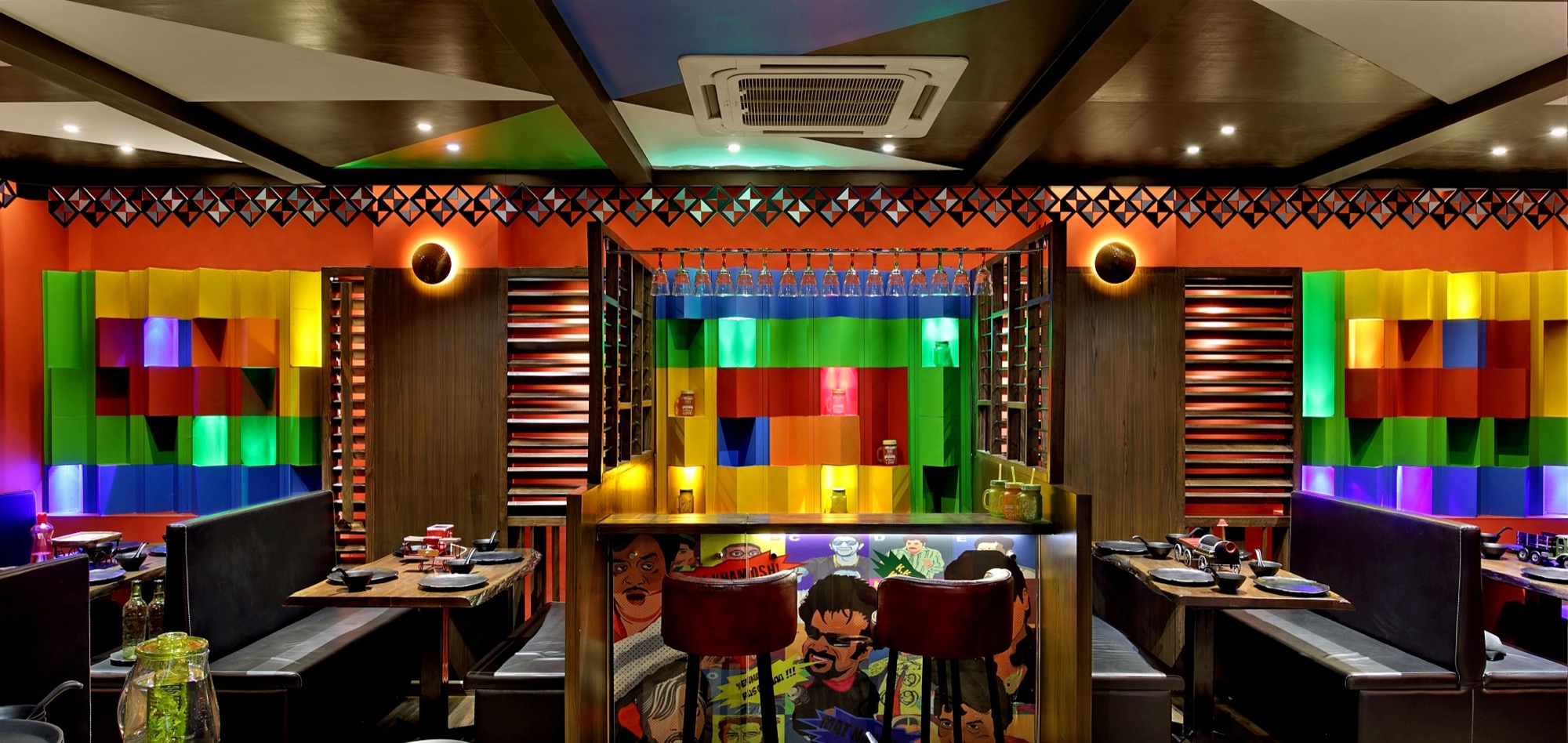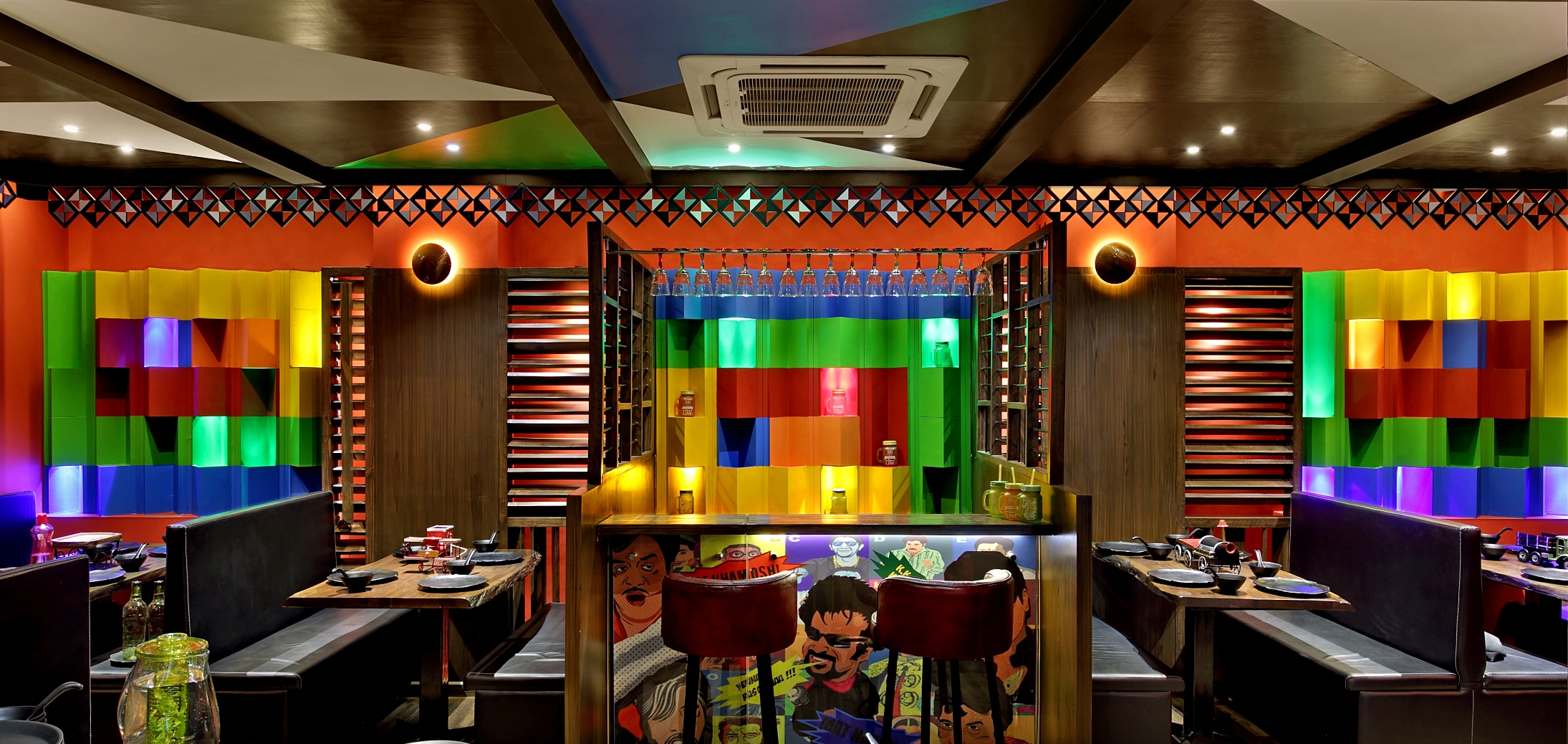 Designed by Manoj Patel Design Studio, located in the prime area of Vadodara, the dhaba style restaurant with 1200 sqft on ground focuses to design and evolve a new theme based on diverse dimensions of vibrant aesthetics , culture , functionality and design aspects with urban context in limited budget.
Designed by Manoj Patel Design Studio, located in the prime area of Vadodara, the dhaba style restaurant with 1200 sqft on ground focuses to design and evolve a new theme based on diverse dimensions of vibrant aesthetics , culture , functionality and design aspects with urban context in limited budget.
Experimenting the prospectivity of the space the interiors are designed in previously unforeseen ways giving a visual and narrative experience of theme based dhaba. The designing team transforms this erstwhile space of dhaba through combination of contemporary impressions with traditional aesthetics of strong triangular geometry and bright lighting into the interiors.
The view from the glass doorway exhibits one wall continuing the theme of louvered panels while the other is resemblance of elegant voluminous massing of wooden templates which gives a clear idea where you may like to sit in the distinct seating options that are available. Seating arrangements work in various patterns according to the compact character of the space underlying material palette of wood , mdf boards and resin for seatings which compliments the space around.

The visitors can move along the circulation spine , glimpsing the various catchy bollywood – pizza based theme posters like – “Don ko dhabese nikalana muskhil he nahe namumkin hai..!!” , “mogambo pizza se khush hua..!!” to division of volumetric vibrant void templates overlapping strong geometry on the walls and ceiling of the space.
Exploring the bar seatings one can find the wooden members lined bar with striking red, green , blue and yellow solid as well as hollow voids creates pockets at the backdrop to hold artifacts and displays on along the series of inverted mocktail glasses placed over set a nice ambience for a peaceful space.
The ecology of spaces and built form encompasses high raised isolated seatings of flexible wooden louvered cubicles operable by single or double flaps also with various quirky bollywood posters at the entrance of the gateway to have privacy experience of amalgamating various functions with deriving architectural balance of the space.
The space further also focuses on mass seatings with comfortable dinning space with evident material backdrop play of large 3 dimensional voluminous wooden templates inserted smoothly within volumes to add layers of illusion and surprises to experience of space making through vibrant colorful combinations with identical led lights to harmonize creating a dramatic feel. The colorful volumes evolve from rotating and replicating the square quadrants with interplay of volumetric and triangular surfaces adding warmth to the surroundings. The material play of voids creates shadows on its own surface.
The central innovative compact space smartly incorporates the display of salad counter, an essentially a covered space which encloses around 2 major columns on both the sides of cladding with wooden members around , across the dhaba space making the visitors to circulate comfortably and establish identifiable space around it making the focal point.
The links between the exterior and interior spaces with delineate framework of east facing louvered panels at various angles allows the control of natural light flow with led lights fit in , are brief niches in the vision creating a see through screen. This feature of day lighting turns out to be economical and easy to handle.
Also the ceiling incorporates the abstracts from main elevational look of voluminous wooden template triangles in the design with bright led lights which cast delightful shadows in color and intensity with miniature torans of laser cutout triangles from mdf boards running all around forming twisted variations setting a connection among the vibrant space.
The door depicts the same signage treatment of vibrant voids theme vertically applied in door handle details intact with colorful tinted glass panels giving an olden fabric graphical look. This creates a unique welcome element recreated from olden fabrics desiring for theme based dhaba.
In order to incorporate this design the team introduces a place full of visitors to enjoy the modern based dhaba which targets triangles into the ceilings as well as wall massing to divert the direction towards the focal point of the dhaba space. The lighting , boldness of the space with shades of red , blue , green and yellow here also define a sense of connectivity for the ceiling where furniture compliments , developing this overall atmosphere. The focus turns towards interior details and incorporating items to harmonize with the setting in rustic manner that contribute to the unique identity of the place.
Project title – PIZZA DA DHABA
Architect : Manoj Patel Design Studio
Website : www.manojpateldesignstudio.com
Email : ma**************@***il.com
Completion Year : June 2018
Project Location : Vadodara, Gujarat, India
Design Team : Manoj Patel, Shivani Tamboli, Ajay Prajapati, Nirmal Arapada
Photographer : Tejas Shah
Text : Aishwarya Gupte
























